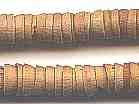Your path =Home>Beadmaking & Materials>Organic Materials> Eucalyptus
Wandering Eucalyptus
Scene 1: The National Museum of Anthropology, México (Mexico City), Spring 1987.
|
Scene 2: Monte Albán, near Oaxaca, a week or so later.
As tourists descent from the heights of this magnificent ruin, they are met by young girls selling strings of beads. What's this? The same little yellow cones strung exactly as they were in the National Museum and another string with the cones pierced side to side so they looked like tiny bells. They were extremely cheap; I bought one of each.
Scene 3: A few hours later, in my room talking to the young manager of the hotel I was staying in, we having become friends.
I showed him the beads I bought and he immediately identified them as eucalyptus. I was astonished and protested that eucalyptus was native to Australia. He knew that, but said if I didn't believe him, I should go a couple blocks this way and a couple that until I got to an old church.
Scene 4: The Old Church
So, the next day I followed his directions. Sure enough, there was the church with four huge eucalyptus trees shading its front plaza.
At the base of the trees were some of the little yellow cones, though not many because it wasn't the season.
You can always recognize certain eucalyptus trees because, while most trees shed their leaves and keep their bark, they shed their bark and keep their leaves. I used to walk through the King's eucalyptus grove on my way to and from the University of Fez when
I lived in Morocco. It makes great charcoal, a major heating source in that country (I used charcoal to keep me warm on long winter nights).
|
The very word "eucalyptus" refers to the conical cap that covers the bud and later the fruit in a unique manner. It comes from the Greek eu, an adverb meaning "well" and kaluptw
"to cover or conceal" thus, "well hidden (by the cap)."
Now, here is my question: Clearly the valuable eucalyptus was transplanted from Australia to Mexico at some time. But, who taught little Mexican girls to string the caps into beads?
I doubt the knowledge of this byproduct of these lofty trees was transferred with the trees (though maybe it was). Do we have a case of the independent invention of using eucalyptus caps as beads in two geographically distant places? I wonder.
__________________________________________________
Small Bead Businesses | Beading & Beadwork | Ancient Beads | Trade Beads
Beadmaking & Materials | Bead Uses | Researching Beads | Beads and People
Center for Bead Research | Book Store | Free Store | Bead Bazaar
Shopping Mall | The Bead Auction | Galleries | People | Events
The Bead Site Home | Chat Line | Contact Us | Site Search Engine | FAQ

